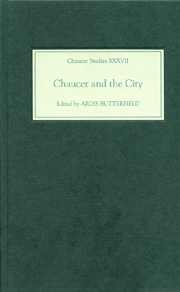Book contents
- Frontmatter
- Contents
- List of Illustrations
- Dedication
- Preface
- List of Contributors
- Abbreviations
- Map
- INTRODUCTION
- LOCATIONS
- COMMUNITIES
- 5 Chaucer and the Language of London
- 6 The Canterbury Tales and London Club Culture
- 7 London and Southwark Poetic Companies: ‘Si tost c'amis’ and the Canterbury Tales
- INSTITUTIONS
- AFTERLIVES
- Bibliography
- Index
- CHAUCER STUDIES
6 - The Canterbury Tales and London Club Culture
from COMMUNITIES
Published online by Cambridge University Press: 05 February 2013
- Frontmatter
- Contents
- List of Illustrations
- Dedication
- Preface
- List of Contributors
- Abbreviations
- Map
- INTRODUCTION
- LOCATIONS
- COMMUNITIES
- 5 Chaucer and the Language of London
- 6 The Canterbury Tales and London Club Culture
- 7 London and Southwark Poetic Companies: ‘Si tost c'amis’ and the Canterbury Tales
- INSTITUTIONS
- AFTERLIVES
- Bibliography
- Index
- CHAUCER STUDIES
Summary
Investigations into the historical reality of a writer's audience often end before they have begun, with acquiescence in the proposition, argued by W. J. Ong in an influential essay of thirty years ago, that ‘The Writer's Audience is Always a Fiction’. This proposition is always to some extent true, is more or less taken for granted by the private silent reader, and is an attractive alternative to the frustrations that commonly attend efforts to establish a historical audience on the basis of evidence that is necessarily patchy and inadequate. Such frustrations often find release in the speculative re-creation of historical audiences simply as a means of providing a spuriously historical warrant for interpretations that the reader has arrived at by the usual process of making them up. A further attraction of the idea of the ‘fictional’ audience is that it falls in so happily with reception theory, in giving imagined later audiences equal rights with an imagined earlier one. As Wolfgang Iser says, in his elaboration of a phenomenology of reading (the interaction between the text and the reader as part of a theory of literary communication), there are great difficulties in reconstructing the historical readership from internal sources. We cannot know whether it is ‘the real reader of the time’ which is meant or ‘the role which the author intended the reader to assume’, and in such a case the latter is bound to be preferable in a text-based theory.
- Type
- Chapter
- Information
- Chaucer and the City , pp. 95 - 108Publisher: Boydell & BrewerPrint publication year: 2006

